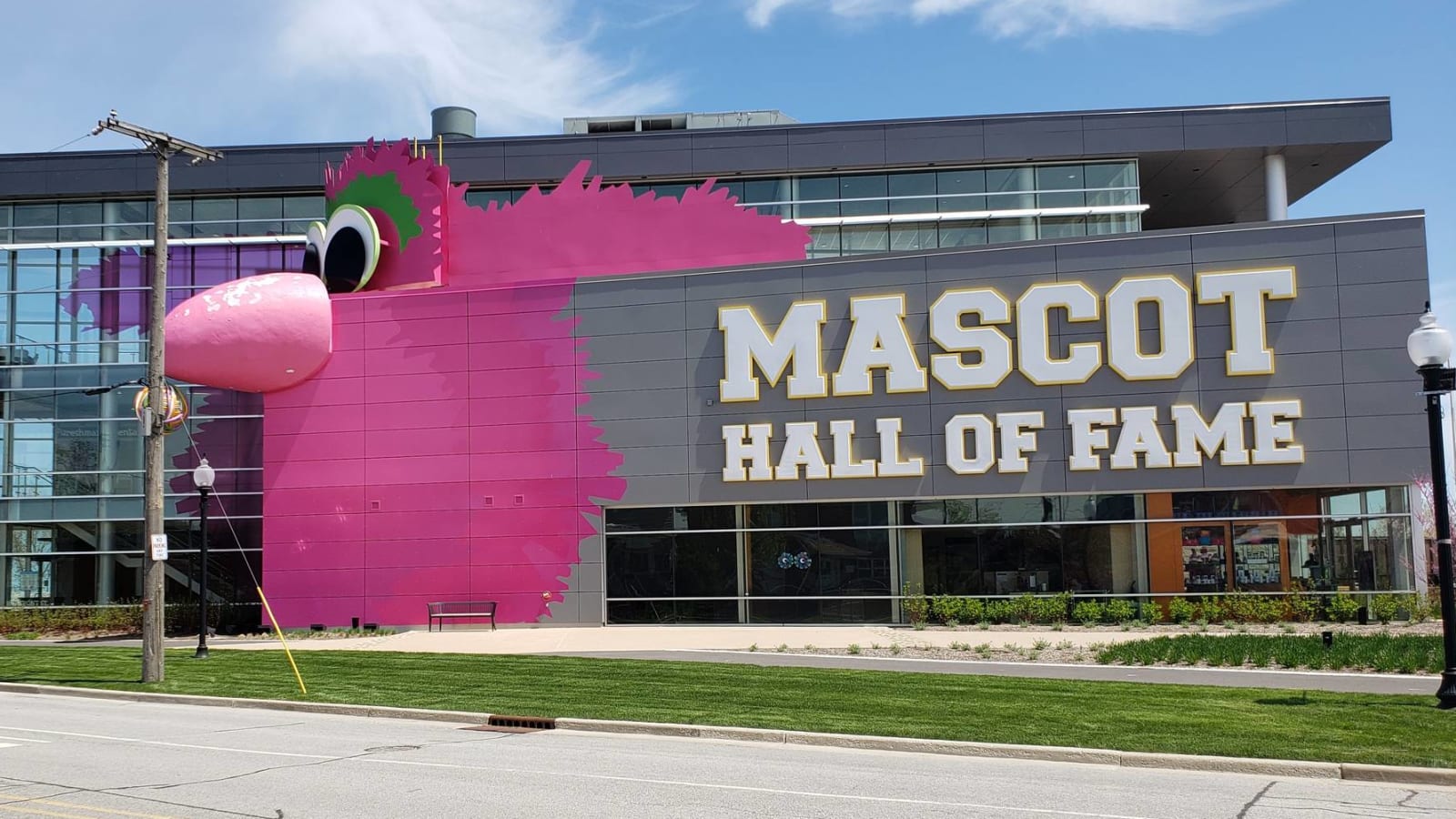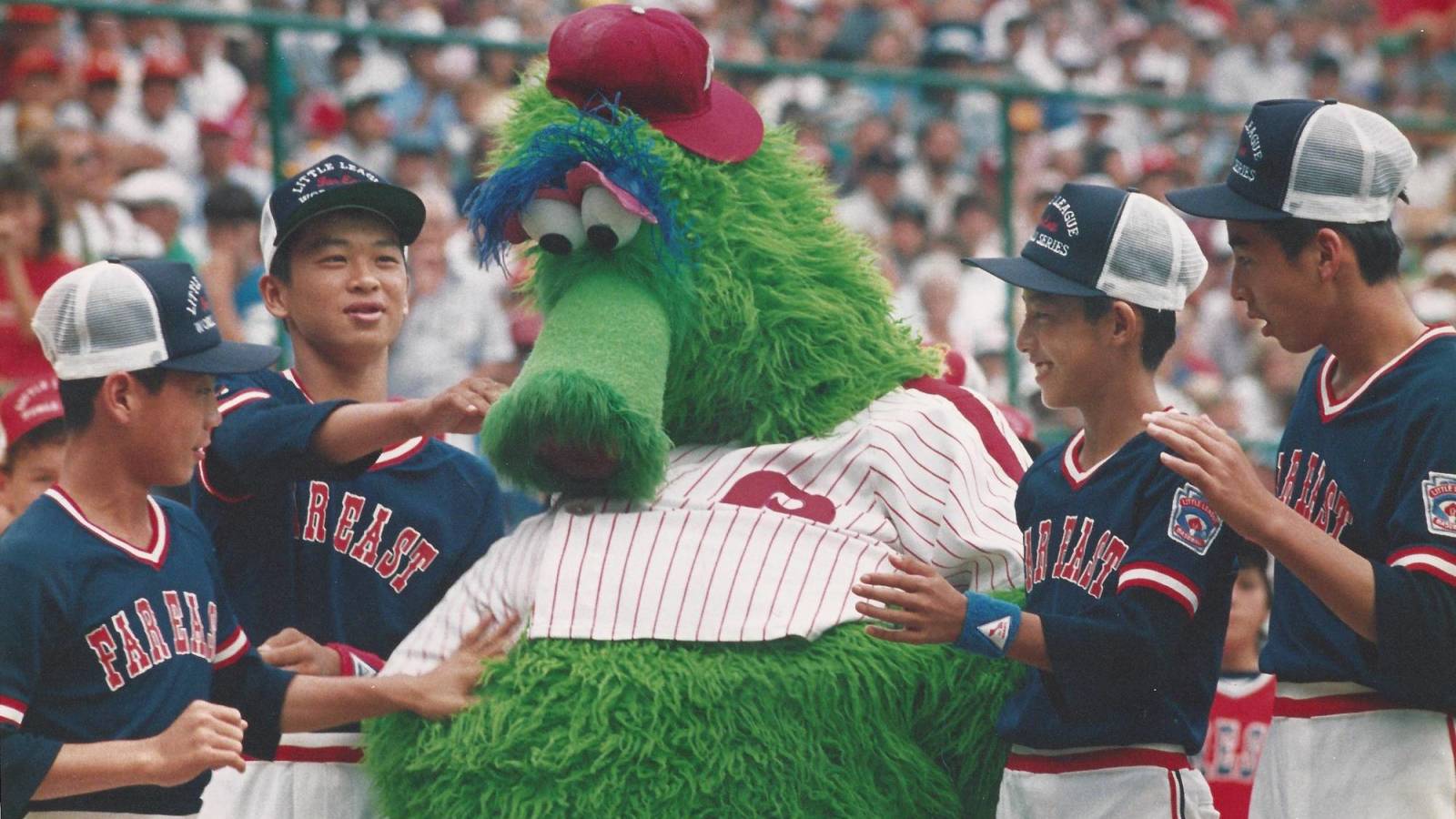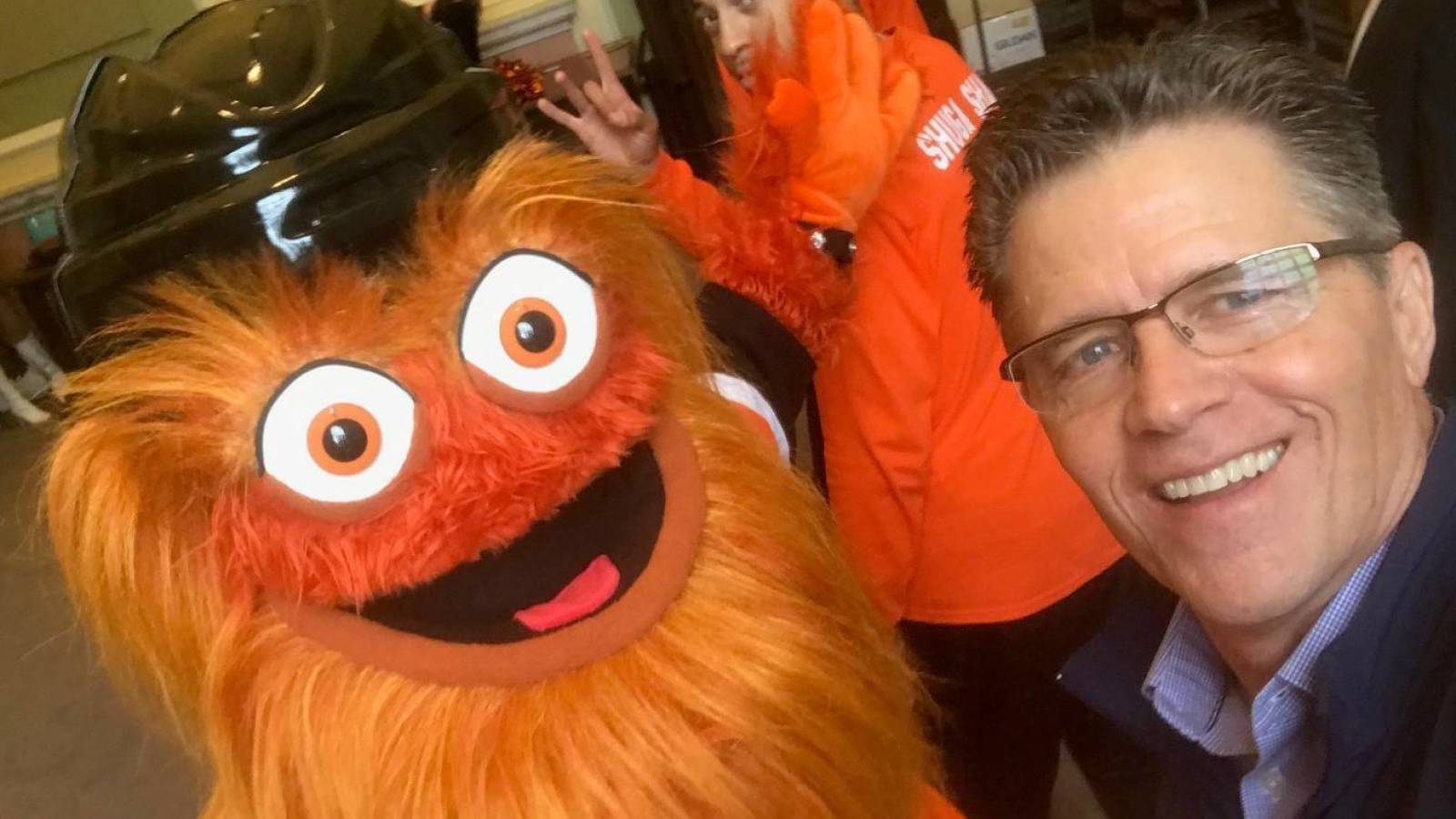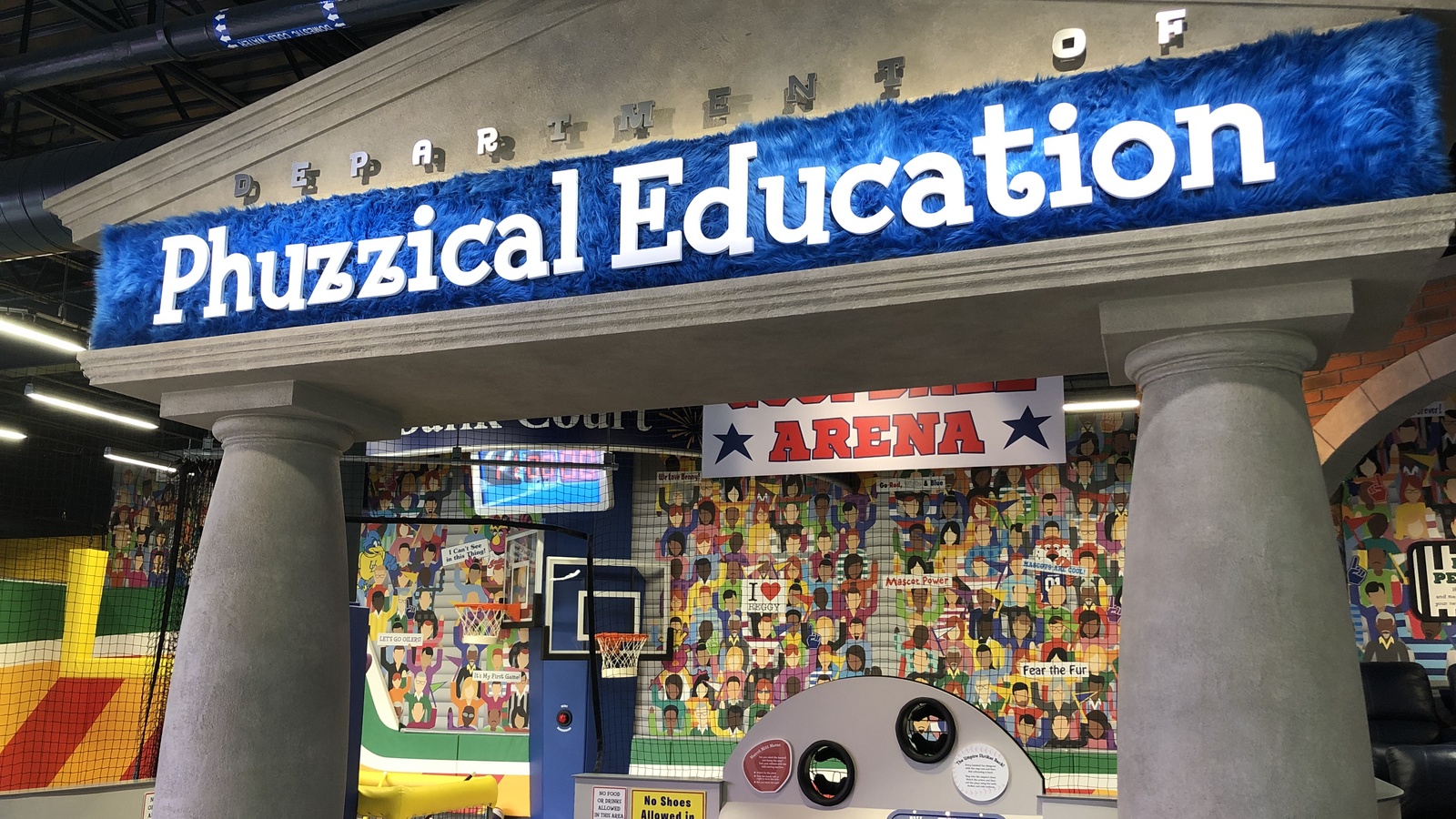
'Unsung heroes': In Indiana, a quirky hall of fame honors sports mascots
WHITING, Ind. -– To hear David Raymond put it, the opening of a brick-and-mortar home for the Mascot Hall of Fame ranks among the greatest events of his life.
“It’s indescribable,” he says. “... It’s like the day I got married. It’s like when I saw my kids being born. While those are above it, this is a real close second.”
Raymond, 63, isn’t famous, but his former alter ego once was. As the original Phillie Phanatic, the chubby, long-nosed, furry green mascot of the Philadelphia Phillies, Raymond worked at old Veterans Stadium from 1978-93. He tooled around in his ATV, teased fans, playfully taunted opponents and wrestled Dodgers manager Tommy Lasorda.
After putting on the costume for the final time, Raymond was instrumental in creating, developing, training and promoting mascots. Today, he runs a marketing company that specializes in branding for mascots. In 2005, he started an online Mascot Hall of Fame to honor great sports mascots. But Raymond dreamed of something bigger than simply a virtual home.
Thanks to his vision, a fun-loving mayor and a little luck, the Mascot Hall of Fame was constructed in Whiting, an Indiana refinery town about 20 miles southeast of downtown Chicago. The 25,000-square foot, $18-million building opened the day after Christmas last year with exhibits that include massive mascot heads and a virtual T-shirt tossing machine.
“The legacy is to really give the mascots a place -- the unsung heroes of the sports world,” says Raymond. “A place [for them] to be applauded and honored.”


Before we take a tour of the Mascot Hall of Fame, let’s learn why one exists in the first place. Hop into our baseball time machine and set the controls for July 9, 2003, Miller Park, Milwaukee, Wisconsin. That’s when Pittsburgh Pirates first baseman Randall Simon, leaning over the railing of the visitors’ dugout, playfully hit one of the Brewers’ famous racing sausages in the head with a bat.
The Italian Sausage, played by a female college student, fell to the ground, knocking down another sausage in the process. Simon was suspended for three games and fined $2,000 by Major League Baseball. Other, less-publicized instances of mascot abuse had occurred over the years. This incident, replayed countless times on television, drew scrutiny from the media.
“I got phone calls from NBC, CBS, ABC and Fox the next day,” says Raymond. The former Phillie Phantic was asked by media what he thought about the “mutilation of the sausages.”
Urged by his friend Chris Bruce – whose alter ego is Reggy the Purple Party Dude, a sports entertainment character -- Raymond organized a march promoting the good work of mascots. It was a tongue-in-cheek publicity stunt more than anything. About 30 mascots participated in the march for mascot rights in Philadelphia. In 2004, another, similar march drew nearly 100 mascots.
Spurred by Bruce, Raymond created the online-only Mascot Hall of Fame -- The Phillie Phanatic, The Gorilla of the Phoenix Suns and the Famous (San Diego) Chicken were initial “inductees.” The first induction ceremony, held in Philadelphia, surprisingly drew an estimated 4,000 people. Other induction ceremonies were held throughout the country. But the events eventually became expensive and time-consuming for Raymond to hold without sponsorship money. And he had a day job, after all.
Given the popularity of sports mascots, the former Phillie Phanatic and Bruce wondered if a building for a Mascot Hall of Fame would be viable. It was more a dream than anything.
“We were joking, you know, somebody will call us and say, ‘We want to build it,’” Raymond says. “In business, that never happens … Then we got the call.”

In 2014, Raymond was contacted by a consultant who worked with Joe Stahura, the mayor of Whiting, about constructing a Mascot Hall of Fame in the Indiana town (population about 5,000). “I thought somebody was pranking me inside my organization,” Raymond says.
A lifelong Whiting resident, die-hard Chicago Cubs fan and former sports collectibles store owner, Stahura was serious. Whiting’s claim to fame is Pierogi Fest, a weekend Eastern European food and culture festival that attracts nearly 300,000 people every July. The event features Mr Pierogi, who mingles in the crowd, high-fiving kids. In 1993, scenes from "Rudy," one of the top sports movies of all time, were filmed in town.
The festival and a redeveloped lakefront project along Lake Michigan made Whiting a popular local destination. But Stahura, mayor since 2003, wanted a year-round attraction, preferably something that would interest families with children. The town had the land, about a football field from the shores of Lake Michigan. He thought a museum, ideally something interactive, would be a terrific addition. In keeping with the tradition of Pierogi Fest, he wanted something a little wacky and fun.
“Out of the clear blue sky, one of our consultants found Dave’s website,” Stahura says. “And we just cold-called him and asked him, ‘What do you think?’”
After realizing he was not being punked, Raymond learned more about Whiting. Then he traveled to small Indiana town for a meeting with the mayor. He liked Stahura’s pitch. They reached an agreement to build a museum. Whiting’s redevelopment commission funded most of the multi-million-dollar project. Raymond says he raised nearly $900,000.
“At some point in the process we realized that we have something special,” says Stahura. “Let’s not blow it. Let’s do it right.”

To get to the Mascot Hall of Fame, visitors drive past a massive oil refinery and through middle-class neighborhoods in Whiting. Hang a left on 121st Street, and soon the giant pink nose and bulging eyes of “Reggy,” the Hall of Fame’s own mascot (of course), comes into view. The Hall of Fame is near the lake and railroad tracks.
Inside, giant inflatable heads of NFL, NHL, NBA, MLB and college sports mascots hang from the ceiling. Visitors can build their own mascot, go under the Phanatics’ head and even experience what the inside of the costume smells like. Mascot memorabilia -- such as Benny the Bull’s original jersey and shoes of Clutch the Bear, the Houston Rockets’ mascot -- is available to inspect.
“We’re trying to bring out the fun side and showcase the silliness of mascots,” says Mascot Hall of Fame executive director Orestes Hernandez, who formerly worked in business development for the Miami Marlins and PGA Tour. “At the same time, [we want to show] why they are so important to the community that they represent.” Hernandez says in early July the MHOF surpassed the 16,000-visitor mark.
The MHOF also includes an interactive children’s museum, and the “Phuzzical Education” area features a digital T-shirt shooting game. Photographs of memorable mascot moments -- including one of the Phillie Phanatic meeting former president Richard Nixon -- are displayed in the “Centuries of Silliness” exhibit.
On Father’s Day Weekend, the Mascot Hall of Fame held its first induction ceremony. Chicago’s Benny the Bull, Sluggerrr (Kansas City Royals), Tommy Hawk (Chicago Blackhawks) and the Nittany Lion (Penn State) were officially inducted. The MHOF’s executive committee, made up of sports personalities and executives and media members, determines who will be inducted. (To be considered, a mascot must be active for 10 years.)
Until the building opened, Raymond and Stahura struggled to explain the mission of the MHOF to potential sponsors, donors and community members. Now people may see for themselves how mascots touch the lives of sports fans.
“Fun is exceptionally powerful,” says Raymond. “It’s a unifier. It crosses all borders and barriers and circumstances and races and sex.
The Mascot Hall of Fame, he adds, “is a living, breathing example of why mascots are so powerful.”
More must-reads:
- My crazy life as 21-year-old road manager for The Famous Chicken
- The weirdest sports mascots, past and present
- The 'NBA Slam Dunk Contest winners' quiz
Breaking News
Customize Your Newsletter
 +
+
Get the latest news and rumors, customized to your favorite sports and teams. Emailed daily. Always free!

